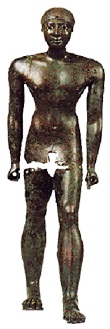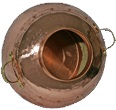Riveted Union Technique

A rivet is a small metal pin used to fasten flat pieces of metal together. It is a cylinder with forged heads, one formed at the time of making the rivet, and the other formed on the hot rivet after it has been inserted. The joining of parts by these cylindrical fasteners passing through holes dates back to Egyptian times. The ancient Egyptians developed metalworking that possessed an excellence that, in some respects, has never been surpassed. Throughout Egyptian history, the same smiths who worked on precious metals also worked with copper and bronze.

Almost every fashionable Egyptian possessed a hand mirror made of polished copper, bronze, or silver. Copper pitchers and basins for handwashing were discovered in tombs. Basins and the bodies of the ewers (pitchers) were hand-hammered from single sheets of copper. The spouts were cast in molds and attached to the bodies by means of copper rivets. All decorative metalwork was executed with a hammer. The separate parts of each item were hammered out individually and then assembled using rivets, or they were pinned onto a solid core (as soldering had not yet been invented). Plates of hammered copper were shaped into statues, with the separate parts joined together using copper rivets. An extraordinary example of such work is the life-size Egyptian statue of Pharaoh Pepi I in the Egyptian Museum in Cairo.
Connections between metal parts are required in most applications and are a critical aspect of every design. Rivets have been utilized in major metallurgical constructions, including the assembly of airplanes, ships, and steam engines. These connections have proven to be highly reliable, providing excellent service. Today, in heavy steel fabrication, welding has almost completely replaced riveting as the primary means of making connections.
Pot stills, also known as alembics or alquitars, have always been made using rivets, a tradition introduced by the Moors in the Iberian Peninsula. This method is traditional for joining the different parts that make up the still. Although many stills are now soldered, the riveted construction is still preferred by the elderly and many others.


This traditional method of joining the three separate parts that make up the copper pot (bottom, belly, and top) has improved with the passage of time. To ensure the pot is entirely impermeable, a linseed oil solution (a mix of linseed oil and other natural ingredients) is applied to all the interior seams. To remove excess linseed oil and block any passages, it is recommended to process a distillation of clean water with rye flour (refer to Cleaning & Maintenance) to remove the excess linseed oil and also to block any passages. However, if after one distillation, you still notice some of this solution on the walls of your pot, DO NOT SCRAPE IT OFF, as doing so may cause your pot to leak. Any remaining excess solution will gradually disappear with continuous distillation and will not affect or influence whatever you want to distill. A small booklet with complete cleaning guidelines and detailed basic instructions will be sent to you after the purchase is made.

